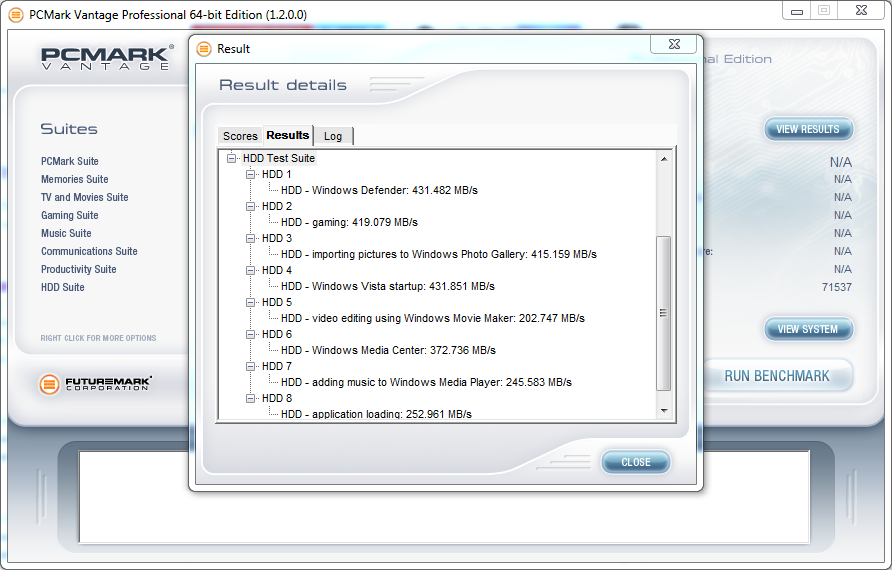The SSD Review uses benchmark software called PCMark Vantage x64 HDD Suite to create testing scenarios that might be used in the typical user experience. There are eight tests in all and the tests performed record the speed of data movement in MB/s to which they are then given a numerical score after all of the tests are complete. The simulations are as follows:
- Windows Defender In Use
- Streaming Data from storage in games such as Alan Wake which allows for massive worlds and riveting non-stop action
- Importing digital photos into Windows Photo Gallery
- Starting the Vista Operating System
- Home Video editing with Movie Maker which can be very time consuming
- Media Center which can handle video recording, time shifting and streaming from Windows media center to an extender such as XBox
- Cataloging a music library
- Starting applications
MICRON M600 SSD PCMARK VANTAGE RESULTS
The Micron M600 256GB SSD achieved a Total Score of 71,537 points. The highest transfer speed of 431.85MB/s was recorded during the “Windows Vista startup” benchmark. As a result this show cases the main reason for using SSDs in the first place, fast loading performance and less down time. The lowest of 245.58MB/s was recorded during the “adding music to Windows Media Player” benchmark.
POWER CONSUMPTION
For our power consumption testing, we have the drive connected to the system as a secondary drive. In order to get a power reading from this mSATA form factor drive, we have connected to an mSATA to SATA adapter as well. To record the wattage, we use an Amprobe AM-270 multimeter connected in line with the 5v power on our SATA power cable to the drive. The multimeter records the min/max amperage draw from the drive over our testing period. We also record the drive’s sequential and random read and write power draw using Anvil Storage Utilities. We then take the values recorded and calculate the wattage of the drive. Some of the results may seem high compared to a standard notebook HDD because as these are peak values under load. When we see average power draw, SSDs are still more power efficient because they only hit max power for a short period of time.
Idle power consumption is on point at 95mW, just 5mW under the 100mW rating. The drive is rated for a max power draw of 4.4W and based on out peak result, it was able to stay within spec. As a result of having two extra NAND packages over the M.2 2280 model, the power draw during sequential reads and writes are around 1 watt more.
REPORT ANALYSIS AND FINAL THOUGHTS
As NAND die shrinks continue and density increases, the less amounts of NAND packages are needed to reach higher capacities. This is great from a cost standpoint, less NAND equals lower end product cost. However, there is an issue, the less NAND packages on an SSD, the harder it is to reach full controller channel parallelism. This means that drives take a hit in write performance as less NAND is implement in the design. It is easy to see this when we compare the split development of the latest Crucial MX100 and Micron M600 SSDs.
At 256GB capacities, the M600 is able to out gun the MX100 in sequential writes, 510MB/s vs 330MB/s, due to Micron’s dynamic write acceleration. What is more impressive is that the mSATA drive is able to do it with half the NAND of the MX100 and the M.2 variant is able to achieve the same write speed of 510MB/s with only two NAND packages!
The mSATA M600 has shown good performance in out testing. Even with its more compact design it was easily able to reach its rated speeds and most figures wound up almost the same as its 2.5″ and M.2 brothers. These small form factor drives have shown Micron’s innovative side in the industry. When we thought static SLC caching was the only option, they thought outside the box. Micron did well on their choice to split their product line development this time, only time will tell what they have in store for us next.
 The SSD Review The Worlds Dedicated SSD Education and Review Resource |
The SSD Review The Worlds Dedicated SSD Education and Review Resource | 


Just checking intro comment “Over the next few years the production of client tablets and notebook PCs will be doubling by OEMs.”
is there is a source for this?
From a graph from Micron: https://i.imgur.com/naC64yw.png